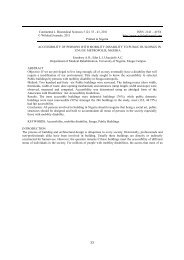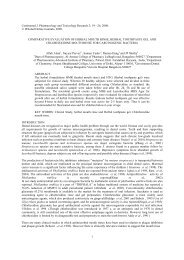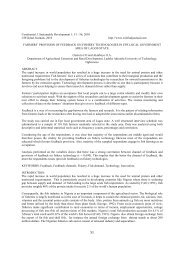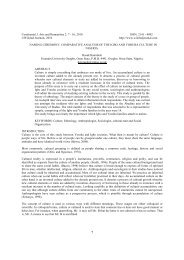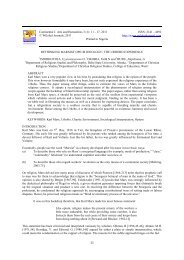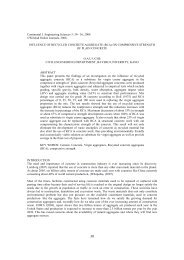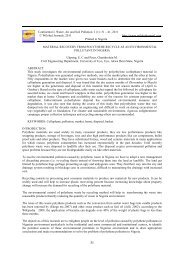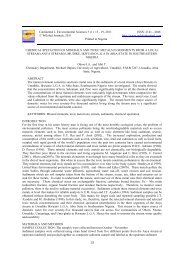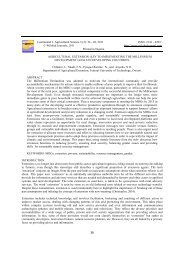Continental J. Earth Sciences 3: 47 - 52, 2008 ... - Wilolud Journals
Continental J. Earth Sciences 3: 47 - 52, 2008 ... - Wilolud Journals
Continental J. Earth Sciences 3: 47 - 52, 2008 ... - Wilolud Journals
Create successful ePaper yourself
Turn your PDF publications into a flip-book with our unique Google optimized e-Paper software.
Aga Tersoo: <strong>Continental</strong> J. <strong>Earth</strong> <strong>Sciences</strong> 3: <strong>47</strong> - <strong>52</strong>, <strong>2008</strong>Banded Iron FormationBanded Iron Formation outcrop in two bands in the northern section of the study area striking approximately inthe N-S direction (Fig. 3). The western arm is approximately 120m wide and occupies about 3.5% of the studyarea while the eastern arm, which occupies about 5% of the study area varies in the width at different pointsalong its length between 170 and 230m.The eastern body is somewhat displaced to about 100m by a fault line.The bodies are characterized by regular alternating thin layers of iron and quartzites.Their contact with schist and marble is sharp. Generally, the iron ore layer varies in thickness from 5 to 10 mmwhile the quartz rich layers are less than 10mm thick. The bands are regular and parallel but occasionally, thequartz bands are white, brown to pale-grey coloured and alternate with dark iron ore rich bands consisting ofiron-oxides, usually some silica. Gangue minerals associated with the iron ores include quartz, zircon andapatite ( Aga, 2000 ).Evaluation of both the BIF and marble bodies were carried out to access the potentials of the huge deposits.METHODOLOGYEstimation of BIF and Marble ReservesThe vertical thickness of the BIF estimated from contours is averagely 30m. Measurements on sections withinboreholes on the marble around Muro Kasa indicate that the thickness varies from 29.70 to 33.05m.The specificgravity of the BIF is 3.60g/cm 3 and the densities of the marble range between 2.49 and 3.17g/cm 3 .Estimation of the Muro Kasa BIF reserves was done using the block method. The planar surface on the map ofthe two BIF bodies were subdivided into blocks of regular geometric form T 1 , T 2 , …T 11 ( Fig.3 ) and thevolume of each block calculated.Blocks T 1 , T 5 , T 7 , T 8 , T 10 and T 11 are trapeziums and have surface areas 59, 150m 2 , 44,500m 2 , 39,600m 2 ,104,250m 2 , 105,600m 2 and 201,250m 2 respectively. Blocks T 2 , T 3 , T 4 and T 8 are rectangular and have surfaceareas 81,400m 2 , 114,000m 2 , 71,000m 2 and 209,000m 2 respectively. Block T 6 is a semi-circle and has an area of1,289m 2 .Total volume of the BIF bodies = Total surface area x average depth= 1, 031, 039m 2 x 30m= 30, 931, 170m 3Total mass of BIF bodies = Total volume x mean density= 30, 931, 170 x 3.6 x 10 3= 1. 113<strong>52</strong>21 x 10 11 kg.= 111, 3<strong>52</strong>, 210 tons of BIFThe same block method was employed to estimate the reserve of the marble bodies. The planar surface of themarble bodies was divided into blocks of regular geometric forms A 1 , A 2 ,…A 6 (Fig. 4).Area of blocks A 2 , A 4 and A 5 which are trapeziums are 171,000m 2 , 1,210,000m 2 , and 1,018,500m 2 respectively.Block A 1 is a semi-circle while A 3 is a rectangle with areas of 45,402m 2 and 253,000m 2 respectively. A 6 is atrapezium less blocks S 1 and S 2 , with an area of 1,101,453m 2 .Total volume of the marble bodies = Total surface area x average depth= 3,798,355m 2 x 31.4m= 119, 268, 3<strong>47</strong> m 3 .Total mass of marble body = Total volume of marble x mean density of the marble= 199,268,3<strong>47</strong> x 2.83 x 10 3= 3.3753 x 10 11 kg50






